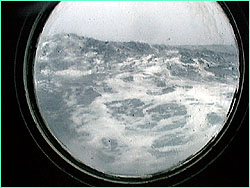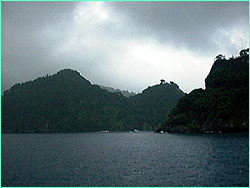 |
 |
 |
by Peter Tyson September 27, 1998 Life began again at precisely 2:14 a.m. this morning. That's when I woke with a start to the sound of what I first took to be a fire alarm. It was the signal that the Undersea Hunter's engine was shutting down. We had arrived at Cocos. The previous 32 hours—the time it took us to pitch, roll, and yaw to the island from Puntarenas—had been a species of death for me. I moved about the boat like a walking corpse, a drowned seaman swum up from Davy Jones' Locker for a final envious look at those still breathing. Out of my sarcophagus of a cabin for a few bites at mealtimes, then back in, lid closed, blackness. I slept 22 of those 32 hours, courtesy of the Triptone anti- seasickness pill I popped every 10 hours or so. When awake, I could not sit upright for more than five or ten minutes before the need for a horizontal position became a desperate one. It was but bitter solace that a few of my highly experienced companions looked as cadaverously wan as I. Delicious was it, then, when I heard the engine die down to silence and noticed that the boat no longer heaved about like a drunken sailor. I was up before dawn to delight in the return of my old self and in the vista that opened off the bow. We were anchored in Chatham Bay. The notorious Chatham Bay, where untold numbers of swashbucklers, buccaneers, and assorted ne'er-do-wells had dropped anchor and often each other in efforts to secure the many treasures supposedly buried here (see Legends and Lore). I tried to imagine pirate ships set against the background of rearing jungle cliffs, wheeling seabirds, and distant misty peaks, but I failed. It was too peaceful, too natural. Nature reigns here.
If it was alive above the surface, it was positively teeming beneath. While the Halls and their film crew made a series of dives to test their equipment and scout potential sites for filming over the coming weeks, Peter Kragh, our Danish-born divemaster, took me on two dives on either side of Manuelita. Eighty feet down on the first, I watched a spotted eagle ray rooting in the sand just as the Halls had captured in IMAX (see the spotted eagle ray in View the Undersea World). A randy marble ray—it is mating season—flapped its graceful wings straight for me in midwater before realizing I was not a potential mate; then it angled down and away. On the reef below Manuelita, I gently touched the ash-gray dorsal surface of a whitetip reef shark, which calmly swam away amidst a dozen or so of its kind resting on the sandy bottom. Kragh ushered me over to a coral head. There, in almost perfect camouflage, sat a scorpionfish. Kragh told me later it was only the second he'd seen in some 400 dives at Cocos.
And not a single human-made object in sight. No garbage, no pieces of rusted metal, nothing to suggest anyone had ever been here. Nature reigns at Cocos. Tomorrow we'll head for Bajo Alcyone and Dirty Rock to look for one species I didn't see today: the scalloped hammerhead. Howard hopes to secure more sequences of hammerhead schools, which at these sites can reach into the hundreds. Peter Tyson is Online Producer of NOVA. Photos: (1,3) Peter Tyson/NOVA/WGBH; (2) ©Michele Hall. Hammerheads or Bust (Sept. 23) Get Used To It (Sept. 25) Nature Reigns at Cocos (Sept. 27) The PIG and the Process (Sept. 29) Hammerheads Sighted (Oct. 1) Assault on Cocos (Oct. 3) The Director's Cut (Oct. 5) Swimming with Whitetip Reef Sharks (Oct. 7) The Magnificent Seven (Oct. 9) The Search for Lake Cocos (Oct. 11) Courtship of the Marbled Rays (Oct. 13) Of Booby and Beebe (Oct. 15) Taken by Surprise (Oct. 17) "This is Cocos, This is Cool" (Oct. 19) Cocos Island | Sharkmasters | World of Sharks | Dispatches E-mail | Resources | Site Map | Sharks Home Editor's Picks | Previous Sites | Join Us/E-mail | TV/Web Schedule | About NOVA Watch NOVAs online | Teachers | Site Map | Shop | Search | To Print PBS Online | NOVA Online | WGBH © | Updated June 2002 |
 View from my porthole during the crossing.
View from my porthole during the crossing.
 Red-footed booby and chick.
Red-footed booby and chick.
 Cocos at dawn.
Cocos at dawn.